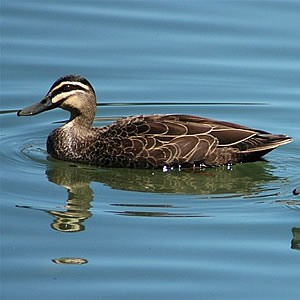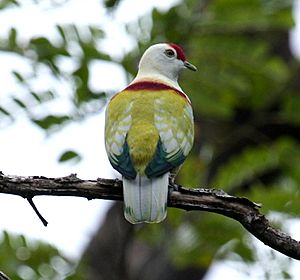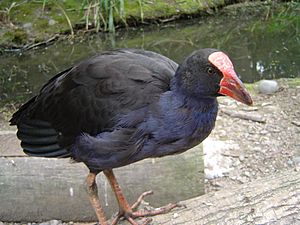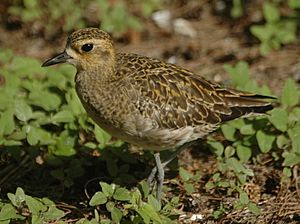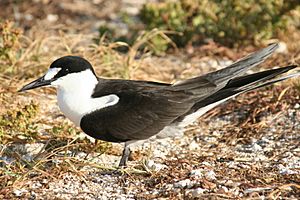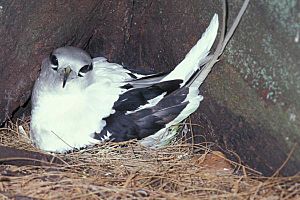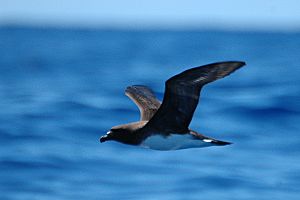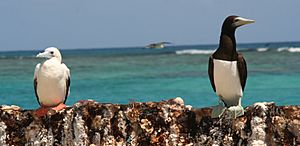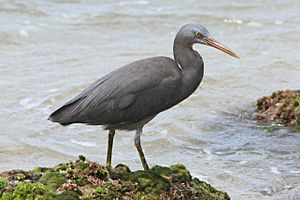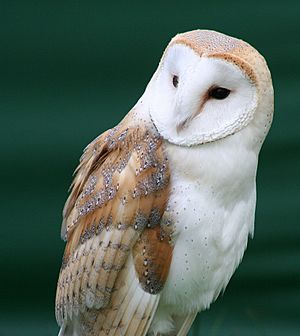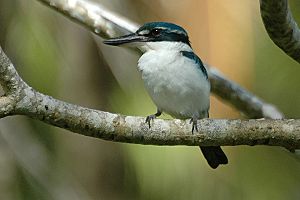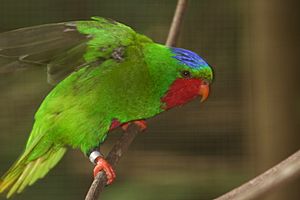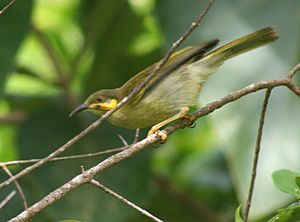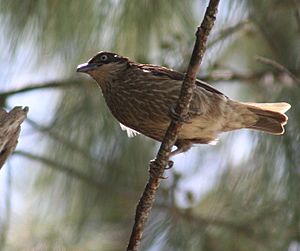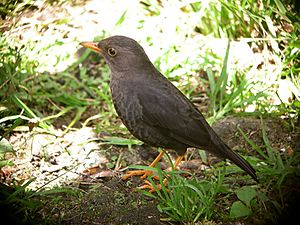List of birds of American Samoa facts for kids
Welcome to the amazing world of birds in American Samoa! This page lists all the different types of birds found here. As of 2023, there are 76 bird species living in American Samoa.
Some of these birds are quite special:
- 15 species are accidental or rare visitors. This means they don't usually live here but sometimes show up by chance.
- 4 species have been introduced by people. They were brought here, either on purpose or by accident, and now live in the wild.
- One bird, the mao, is extirpated. This means it used to live in American Samoa but is no longer found here, even though it still lives in other places.
American Samoa doesn't have any birds found *only* there (called endemic species). However, many land birds live here in large numbers. Lots of seabirds also come to the islands to lay their eggs. Sadly, hunting and animals brought by humans have reduced bird numbers. But places like Lata Mountain on Ta'u Island are still very important breeding spots for birds.
This list uses a special way to organize birds, like putting them into families. This is called taxonomy. The names of the birds, both English and scientific, follow a well-known guide called The Clements Checklist of Birds of the World.
You'll see some special tags next to the bird names:
- (A) Accidental - A bird that rarely or accidentally visits American Samoa.
- (I) Introduced - A bird brought to American Samoa by people.
- (Ex) Extirpated - A bird that no longer lives in American Samoa, but still lives elsewhere.
Contents
- Ducks, Geese, and Waterfowl
- Pheasants, Grouse, and Allies
- Pigeons and Doves
- Cuckoos
- Swifts
- Rails, Gallinules, and Coots
- Plovers and Lapwings
- Sandpipers and Allies
- Skuas and Jaegers
- Gulls, Terns, and Skimmers
- Tropicbirds
- Southern Storm-Petrels
- Shearwaters and Petrels
- Frigatebirds
- Boobies and Gannets
- Herons, Egrets, and Bitterns
- Barn-Owls
- Kingfishers
- Old World Parrots
- Honeyeaters
- Monarch Flycatchers
- Bulbuls
- Starlings
- Thrushes
- See also
Ducks, Geese, and Waterfowl
Order: Anseriformes Family: Anatidae
This family includes ducks, geese, and swans. These birds are perfect for life in water! They have webbed feet, flat bills, and oily feathers that shed water easily.
- Northern shoveler, Spatula clypeata (A)
- Pacific black duck, Anas superciliosa
- Eastern spot-billed duck, Anas zonorhyncha
Pheasants, Grouse, and Allies
Order: Galliformes Family: Phasianidae
The Phasianidae family includes birds like quails, partridges, and pheasants. They usually live on land. These birds are often plump and have broad, short wings.
- Red junglefowl, Gallus gallus (I)
Pigeons and Doves
Order: Columbiformes Family: Columbidae
Pigeons and doves are birds with sturdy bodies, short necks, and thin bills. They also have a soft, fleshy area at the base of their bill called a cere.
- Rock pigeon, Columba livia (A)
- Shy ground dove, Alopecoenas stairi
- Many-colored fruit-dove, Ptilinopus perousii
- Crimson-crowned fruit-dove, Ptilinopus porphyraceus
- Pacific imperial-pigeon, Ducula pacifica
Cuckoos
Order: Cuculiformes Family: Cuculidae
The Cuculidae family includes cuckoos. These birds come in different sizes. They have slender bodies, long tails, and strong legs. Some cuckoos in the Old World are known for laying their eggs in other birds' nests.
- Long-tailed koel, Urodynamis taitensis
Swifts
Order: Caprimulgiformes Family: Apodidae
Swifts are small birds that spend most of their lives flying. They have very short legs and almost never land on the ground. Instead, they perch on vertical surfaces. Many swifts have long, curved wings that look like a boomerang.
- White-rumped swiftlet, Aerodramus spodiopygius
- Australian swiftlet, Aerodramus terraereginae
Rails, Gallinules, and Coots
Order: Gruiformes Family: Rallidae
Rallidae is a big family of small to medium-sized birds. It includes rails, crakes, coots, and gallinules. They usually live in thick plants near wet places like lakes or swamps. They are often shy and hard to spot. Most have strong legs and long toes, which help them walk on soft ground. They tend to have short, rounded wings and are not strong fliers.
- Buff-banded rail, Gallirallus philippensis
- Black-backed swamphen, Porphyrio indicus
- Australasian swamphen, Porphyrio melanotus
- Spotless crake, Zapornia tabuensis
Plovers and Lapwings
Order: Charadriiformes Family: Charadriidae
The Charadriidae family includes plovers and lapwings. These are small to medium-sized birds with compact bodies and short, thick necks. They have long, often pointed, wings. You can find them in open areas all over the world, usually near water.
- Pacific golden-plover, Pluvialis fulva
- Masked lapwing, Vanellus miles (A)
Sandpipers and Allies
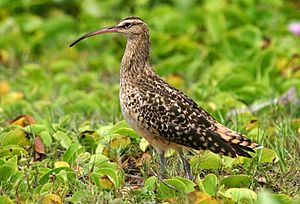
Order: Charadriiformes Family: Scolopacidae
Scolopacidae is a large family of shorebirds. It includes sandpipers, curlews, godwits, and tattlers. Most of these birds eat small bugs they find in mud or soil. Their different leg and bill lengths allow many species to feed in the same places without competing for food.
- Bristle-thighed curlew, Numenius tahitiensis
- Whimbrel, Numenius phaeopus (A)
- Bar-tailed godwit, Limosa lapponica
- Ruddy turnstone, Arenaria interpres
- Sanderling, Calidris alba
- Wandering tattler, Tringa incana
Skuas and Jaegers
Order: Charadriiformes Family: Stercorariidae
The Stercorariidae family includes medium to large birds. They usually have gray or brown feathers, often with white marks on their wings. They build nests on the ground in cooler parts of the world and travel long distances.
- Parasitic jaeger, Stercorarius parasiticus (A)
Gulls, Terns, and Skimmers
Order: Charadriiformes Family: Laridae
Laridae is a family of medium to large seabirds, including gulls and terns. Gulls are usually gray or white, often with black on their heads or wings. They have strong bills and webbed feet. Terns are generally medium to large seabirds, often gray or white with black on their heads. Most terns catch fish by diving. Terns can live a long time, with some species living over 30 years.
- Laughing gull, Leucophaeus atricilla (A)
- Brown noddy, Anous stolidus
- Black noddy, Anous minutus
- Blue-gray noddy, Anous ceruleus
- White tern, Gygis alba
- Sooty tern, Onychoprion fuscatus
- Gray-backed tern, Onychoprion lunatus
- Bridled tern, Onychoprion anaethetus (A)
- Black-naped tern, Sterna sumatrana (A)
- Greater crested tern, Thalasseus bergii (A)
Tropicbirds
Order: Phaethontiformes Family: Phaethontidae
Tropicbirds are thin, white birds that live in tropical oceans. They have very long feathers in the middle of their tails. Their heads and long wings have black markings.
- White-tailed tropicbird, Phaethon lepturus
- Red-tailed tropicbird, Phaethon rubricauda
Southern Storm-Petrels
Order: Procellariiformes Family: Oceanitidae
The southern storm-petrels are related to petrels and are the smallest seabirds. They eat tiny sea creatures and small fish from the water's surface, often while hovering. Their flight is quick and fluttering, sometimes like a bat.
- White-faced storm-petrel, Pelagodroma marina (A)
- Black-bellied storm-petrel, Fregetta tropica (A)
- Polynesian storm-petrel, Nesofregetta fuliginosa
Shearwaters and Petrels
Order: Procellariiformes Family: Procellariidae
The procellariids are a main group of medium-sized "true petrels." They have nostrils that are joined together and a long, working outer wing feather.
- Herald petrel, Pterodroma heraldica
- Mottled petrel, Pterodroma inexpectata (A)
- White-necked petrel, Pterodroma cervicalis
- Black-winged petrel, Pterodroma nigripennis (A)
- Gould's petrel, Pterodroma leucoptera
- Collared petrel, Pterodroma brevipes
- Phoenix petrel, Pterodroma alba
- Tahiti petrel, Pterodroma rostrata
- Flesh-footed shearwater, Ardenna carneipes (A)
- Wedge-tailed shearwater, Ardenna pacificus
- Sooty shearwater, Ardenna griseus
- Short-tailed shearwater, Ardenna tenuirostris
- Christmas shearwater, Puffinus nativitatis
- Newell's shearwater, Puffinus newelli (A)
- Tropical shearwater, Puffinus bailloni
Frigatebirds
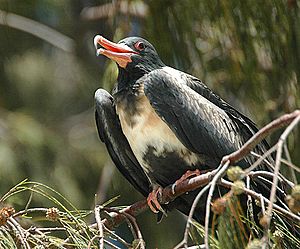
Order: Suliformes Family: Fregatidae
Frigatebirds are large seabirds usually found over tropical oceans. They are big, black and white, or completely black, with long wings and deeply forked tails. The males have colorful throat pouches that they can inflate. These birds don't swim or walk well and can't take off from flat ground. They have the largest wingspan compared to their body weight of any bird, meaning they can stay in the air for more than a week!
- Lesser frigatebird, Fregata ariel
- Great frigatebird, Fregata minor
Boobies and Gannets
Order: Suliformes Family: Sulidae
The sulids include gannets and boobies. Both groups are medium to large seabirds that live near coasts. They dive into the water to catch fish.
- Masked booby, Sula dactylatra
- Brown booby, Sula leucogaster
- Red-footed booby, Sula sula
Herons, Egrets, and Bitterns
Order: Pelecaniformes Family: Ardeidae
The Ardeidae family includes bitterns, herons, and egrets. Herons and egrets are medium to large wading birds with long necks and legs. Bitterns usually have shorter necks and are more cautious. When flying, these birds pull their necks back, unlike other long-necked birds like storks.
- White-faced heron, Egretta novaehollandiae (A)
- Pacific reef-heron, Egretta sacra
Barn-Owls
Order: Strigiformes Family: Tytonidae
Barn-owls are medium to large owls with big heads and special heart-shaped faces. They have long, strong legs with powerful claws.
- Barn owl, Tyto alba
Kingfishers
Order: Coraciiformes Family: Alcedinidae
Kingfishers are medium-sized birds with large heads, long pointed bills, short legs, and short tails.
- Pacific kingfisher, Todirhamphus sacer
- Collared kingfisher, Todiramphus chloris
Old World Parrots
Order: Psittaciformes Family: Psittaculidae
Parrots have strong, curved bills, stand upright, and have strong legs with special clawed feet (two toes forward, two toes back). Many parrots are brightly colored. They range in size from very small (8 cm or 3.1 inches) to quite large (1 meter or 3.3 feet). Old World parrots are found from Africa across Asia and Oceania to Australia and New Zealand.
- Blue-crowned lorikeet, Vini australis
Honeyeaters
Order: Passeriformes Family: Meliphagidae
Honeyeaters are a large and varied family of small to medium-sized birds. They are most common in Australia and New Guinea. They drink nectar from flowers and look a lot like other birds that also feed on nectar.
- Samoan myzomela, Myzomela nigriventris
- Mao, Gymnomyza samoensis (Ex)
- Eastern wattled-honeyeater, Foulehaio carunculatus
Monarch Flycatchers
Order: Passeriformes Family: Monarchidae
Monarch flycatchers are small to medium-sized birds that eat insects. They catch insects while flying.
- Fiji shrikebill, Clytorhynchus vitiensis
Bulbuls
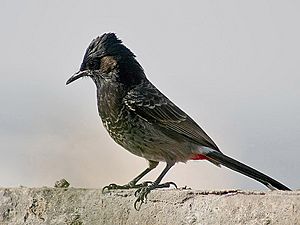
Order: Passeriformes Family: Pycnonotidae
Bulbuls are medium-sized songbirds. Some are colorful with yellow, red, or orange patches, but most are plain, with olive-brown to black feathers. Some species have distinct crests on their heads.
- Red-vented bulbul, Pycnonotus cafer (I)
Starlings
Order: Passeriformes Family: Sturnidae
Starlings are small to medium-sized birds. They fly strongly and directly and often live in large groups. They prefer open areas and eat insects and fruit. Their feathers are usually dark with a shiny, metallic look.
- Polynesian starling, Aplonis tabuensis
- Samoan starling, Aplonis atrifusca
- Common myna, Acridotheres tristis (I)
- Jungle myna, Acridotheres fuscus (I)
Thrushes
Order: Passeriformes Family: Turdidae
Thrushes are a group of birds mostly found in the Old World. They are plump, soft-feathered, and small to medium-sized. They eat insects or sometimes everything, often finding food on the ground. Many have beautiful songs.
- Island thrush, Turdus poliocephalus
See also
- List of mammals of American Samoa
- List of non-marine molluscs of American Samoa
- List of birds
- Lists of birds by region


